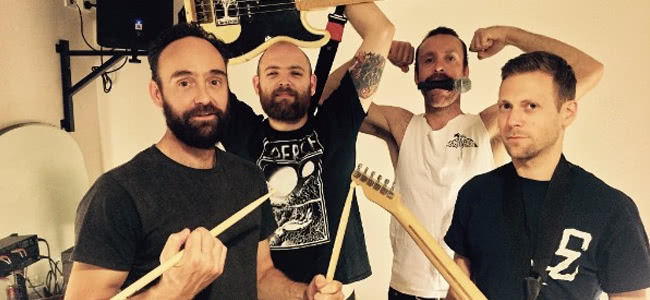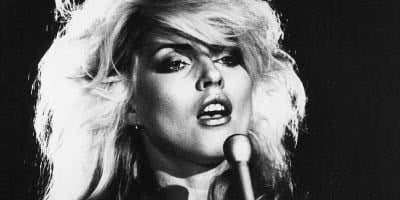Canberra rockers Hoodlum Shouts have returned after four years with a new album, Heat Island, out through Poison City Records.
Having just capped off their album tour, they’re no strangers to the live stage, and know their fair share about what makes good touring gear. Guitarist Mike Caruana gave us a bit of insight into his assortment of axes, and his thoughts on the old question of ‘Tele vs. Strat’.
Their new track ‘Twin Cities’, taken from Heat Island, is a prime example of the sort of punch you can get from the right combination of guitars – and possibly even a carpeted amp.
Essential Gear
I only ever really want my amp in the studio. I always use other amps as well, but mine is the one piece of gear that I see as irreplaceable. It’s reliable, versatile and has a grainy overdrive that I love. It doesn’t necessarily sound amazing or classic, but it has character – and we’ve been through a lot together.
Right now my regular gear is an ’80s Carvin X100B head and 4×12 cab; a standard ’90s Tele with custom pickups; a ’90s Strat Plus with a Hot Rails in the bridge; an Xotic AC booster, Boss tuner, and Boss digital reverb.
Strat vs. Tele
 My first guitar and amp setup was an Ibanez S and a Marshall Valvestate combo, as I started off pretty metal-centric. The first band I started playing guitar in was somewhat established, so once I joined I upgraded to the Carvin and the Strat under the advice of our other guitarist. He also played a Strat and he told me to replace the bridge pickup with something hotter, so I swapped it out. In hindsight, Fenders weren’t the obvious guitar choice for the kind of post-metal we were playing (the guy I replaced used a Les Paul) but I’m thankful that I did choose a Strat over something meatier, as it helped shape the kind of riffs that would later become Hoodlum Shouts songs.
My first guitar and amp setup was an Ibanez S and a Marshall Valvestate combo, as I started off pretty metal-centric. The first band I started playing guitar in was somewhat established, so once I joined I upgraded to the Carvin and the Strat under the advice of our other guitarist. He also played a Strat and he told me to replace the bridge pickup with something hotter, so I swapped it out. In hindsight, Fenders weren’t the obvious guitar choice for the kind of post-metal we were playing (the guy I replaced used a Les Paul) but I’m thankful that I did choose a Strat over something meatier, as it helped shape the kind of riffs that would later become Hoodlum Shouts songs.
The Tele came into play right after we recorded the first Hoodlum Shouts EP, and I prefer it to the Strat for both feel and tone. But the Strat definitely helps to give the band more of a distinct sound.
I’ve never really been huge on pedals or effects, so just a couple get me by. I’ve always just tried to get the best sound out of the gear that I own and tried to avoid buying a heap of gear just for the sake of it. I started out with pretty decent gear and I’ve never had a huge desire to change it. It’s a rock-solid live setup.
Into The Studio
It works well for basic rhythm tracks, but I like to experiment with different amps and effects for alternative tones in the studio.
Early Gear
 I was given a toy acoustic guitar as a really young kid, which I tried to play left-handed and didn’t really take to. My first proper instrument was drums and my first kit was a horrible (but very cool looking) cheapo ’70s Jazz-style kit. I was stoked with it until I realised how much better the kits sounded at music shops. When I started playing guitar I was lucky enough to borrow and learn on a Japanese Strat, which might have given me a distorted understanding of gear ’cause it was so nice to play. I figured all guitars were like that!
I was given a toy acoustic guitar as a really young kid, which I tried to play left-handed and didn’t really take to. My first proper instrument was drums and my first kit was a horrible (but very cool looking) cheapo ’70s Jazz-style kit. I was stoked with it until I realised how much better the kits sounded at music shops. When I started playing guitar I was lucky enough to borrow and learn on a Japanese Strat, which might have given me a distorted understanding of gear ’cause it was so nice to play. I figured all guitars were like that!
Influencing Your Sound
The combination of those Fenders played through that amp is very significant. I suppose you can have all the gear in the world, but you’ve still got to use your ears.
Weird, Old And Obscure
Ha! In my teens I bought a pair of Meinl congas. I wasn’t really into Latin music but I was really into percussion and played music with a guy who loved Santana and cannabis. I ended up selling them pretty soon after. I also bought a cowbell when I was 12 ’cause I idolised Tommy Lee. No really obscure pieces, but a carpeted amp is pretty rare!
My Fender Lead II guitar is pretty old but the piece of gear that I have from back in the day that I still use is a pitch-pipe.
The Gear That Solves Problems?
Our bass player, Morgan.




































